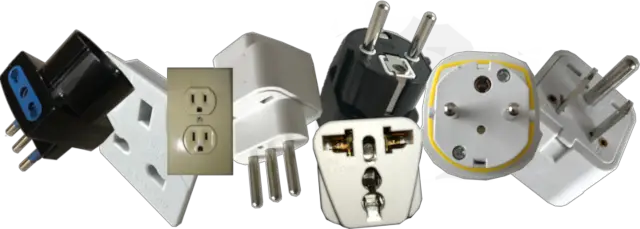Travel Tips for Using Electronics Off the Beaten Path with Taylor Watts
Taylor Watts - February 08, 2024
 Remote Destinations
Remote Destinations
Embark on an electrifying journey with Taylor Watts as we unveil secrets to powering your devices in the most secluded corners of the world. Stay charged and ready for adventure!
Off the Beaten Path: Using Electronics in Remote Destinations 🌍✨
Adventure beckons, travel enthusiasts! 🌟 Are you gearing up to head out into the unknown and explore some of the world's most secluded gems? If you're anything like me, Taylor Watts, the mere thought of discovering remote destinations sends a thrill down my spine. But while we escape to disconnect, let's be real – having our trusty electronics along can make the journey even more enriching (and let's not forget - safe!).
As someone who's seen a fair share of corners off the beaten path and wrangled with my fair share of adaptors and voltages, I'm here to share the lowdown on how to keep your gadgets happily humming along, no matter how far-flung your travels. So, let’s buckle up for an electrifying adventure of a less literal sort.⚡️✈️
🌄 The Prelude: Understanding Your Electronic Companions
Before we dive into the nitty-gritty, let's have a quick chat about the companions you might carry along. Smartphones, cameras, laptops, e-readers, and portable chargers all have a spot in our travel bags. Familiarize yourself with each of their power needs—it's vital for a smooth digital experience as you venture forth.
🔄 Voltage Varieties: One Size Does NOT Fit All
In your electrical escapades, the first thing to note is that not all regions share the same voltage or frequency. The standard voltage can range from a gentle 110V in some places to a robust 240V in others. For United States wanderers, this can be quite a jolt from the usual 120V we're accustomed to.
Tip: Always check the input voltage of your devices. Most modern devices work with voltages ranging from 100V to 240V, which means they can adapt across continents without the risk of an unfortunate power surge.
🔌 Plugging Into the Unknown: Socket Shapes and Sizes
It's a wild world out there, especially when it comes to power sockets! From the triple-pronged Type G of the United Kingdom to the round-pinned Type C commonly found in Europe, socket styles vary far and wide. Don't get caught without a way to power up – make sure you’re carrying the correct adapter for your destination.
Quick Guide to Plug Types: - Type A/B: Mostly used in North America, Central America, and Japan - Type C/E/F: Common across Europe, South America, and Asia - Type G: Predominantly in the United Kingdom, Ireland, and a handful of other countries - Type I: Typical in Australia, New Zealand, China, and Argentina
Need a visual aid? Whatplug.info has a plethora of resources and country-specific guides to help you out! 😏
🚗 Off-Road Charging: Portable Power Solutions
When the map's edges become your starting point, traditional charging methods bid farewell, and you must look to other electricity emporiums. Portable power banks and solar chargers are lifesavers in off-grid locales. For those in RVs or campers, investing in a good quality power inverter can turn DC power from your vehicle into available AC power for your devices.
💡 Illuminating Tip: Travel-Sized Solar Panels
With the eco-conscious traveler in mind, pack along a travel-sized solar panel. It's a fantastic way to embrace renewable energy and ensure your electronics stay charged under the sun's gaze. They fold up nicely and are getting more effective by the year.
🔒 Safety First: Protecting Your Gadgets Against Power Surges
The unpredictable nature of electricity supply in remote areas could mean an increased risk of power surges. A surge protector should be a non-negotiable travel buddy for your electronics. It's like a bouncer at a club – only letting in the good vibes (or volts, in this case)!
🏞️ When Less is More: Economizing Your Electronics
Sometimes, bringing along fewer electronics means fewer worries. Consider the true essentials and perhaps opt for multi-functional devices. Why carry a camera, a laptop, a tablet, and an e-reader when a smartphone might cover all bases? Simplify to amplify your travel experience.
🔋 Battery Basics: Spares and Care
Carrying spare batteries is wise, especially for your camera or other high-drain devices. But remember, treat your batteries right—keep them cool, dry, and away from metal objects. Short circuits aren't the kind of sparks you want on your travels!
🛫 Airline Regulations: Fly Friendly with Electronics
Transporting your tech by air? Keep up-to-date with airline regulations regarding electronics. Lithium batteries, in particular, have strict guidelines. Always carry them in your hand luggage and not in checked baggage to stay within safety guidelines.
💼 Pack Like a Pro: Organization is Key
Organize, organize, organize! Segregate your electronics, chargers, and adapters in easy-to-reach places within your luggage. Compact cases with compartments offer an excellent solution to avoid tangles and confusion. Efficiency is your friend when you’re away from the familiar.
🌩️ Expect the Unexpected: Waterproofing and Weather Proofing
Tropical rainforests, misty mountains, and dew-covered landscapes are stunning – until they turn your devices into expensive paperweights. Waterproof cases and pouches are critical. Even zip-lock bags can be a temporary fix in a pinch. Keep your gadgets snug and dry!
📡 Staying Connected: Internet in Isolation
Craving a digital detox but still need to send a quick update? Remote areas might not have your usual Wi-Fi cafes or hotspots. Satellite devices or unlocked phones with local SIM cards can bridge the gap. Internet might be spotty, but it's part of the off-the-grid charm, right?
Remember: "Just because you're in the middle of nowhere doesn't mean you can't be connected to somewhere." – The Seasoned Traveller's Mantra
🔍 In Summary: Smart Tech Travelling
Embarking into the wilderness with your electronics can be a breeze if you’re prepared. To recap, here's your pre-departure checklist:
- Voltage Vetting: Confirm device compatibility with destination voltages.
- Adapter Arsenal: Equip yourself with the right plug adapters.
- Portable Power: Bring power banks or solar chargers for off-the-grid energy.
- Surge Protection: Invest in a high-quality surge protector.
- Essential Selection: Reassess and limit the electronics you bring.
- Spare Supplies: Pack extra batteries and care for them properly.
- Travel Regulations: Stay informed about airline rules for electronics.
- Efficient Packing: Keep your tech organized and accessible.
- Weatherproofing: Protect against the elements with the right cases.
- Connection Contingencies: Have a back-up plan for staying in touch.
🚀 Conclusion: The World Awaits!
Alright, globetrotters, it's time to take this advice and run with it—straight towards your next uncharted adventure. Using electronics in remote destinations doesn't have to be daunting. With a bit of preparation and smart packing, you'll find that technology can be your ally rather than a liability. Embrace the solitude of starlit skies, the whispers of ancient ruins, and the chorus of distant wildlife – all with a fully charged battery by your side. 🔋😊
Ready to navigate the power puzzle of a new place? Keep checking back at whatplug.info for all your travel power needs!
Safe travels, and may your tech be as resilient as your spirit of exploration. ✨
Until next time, Taylor Watts ⚡️🌲
↬ a link from your website helps too.
